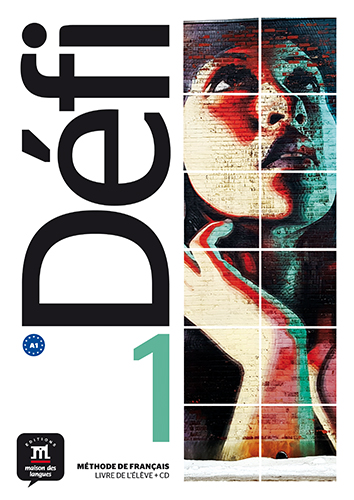

After a decade of using Nouveau Rond Point 1 as the textbook for our first-year beginner French courses, the time for renewal had come. While we were not wedded to Éditions Maison des Langues (EMDL), our commitment to immersion teaching and to a task-based approach ruled out many other recent methods. Our choice of replacement textbook, Défi 1 from EMDL, offers a fully immersive methodology and the promise of digital integration.
This review will offer some insight into a package of materials, rather than just the textbook, since they are indeed marketed as such. In addition to the printed student textbook Défi 1, there is an accompanying printed Exercise Book (Cahier), a digital version of each made available through the publisher’s Espace virtuel, as well as access to the wider offerings of the Espace (other textbooks, videos, a suite of interactive exercises harvested from the publisher’s catalogue of offerings). Students who wish to work on paper only will need to buy the printed version of both the textbook and the Cahier, whereas students who buy the premium print edition of the textbook receive an access code to the Espace virtuel, valid for twelve months, and thus digital access to both books on their desktops, laptops and portable devices. This was a marked improvement from the previous textbook Nouveau Rond Point 1, the digital version of which offered a simple digital flip-book with embedded audio.
The difference between the digital versions of Défi 1 and Nouveau Rond Point 1 is a generational shift in digital integration. Far beyond the mere glorified PDF of Nouveau Rond Point 1, the digital counterpart of the print edition of Défi 1 offers an interactive dimension to almost all the exercises where it makes sense to do so. Click on the pop-up version of an audio comprehension exercise and the student will get not just the audio player, but a more scaffolded version of the comprehension questions than is possible in print (draggable answer labels, for instance). This works quite helpfully to allay the common beginner student fear about needing to understand everything before they can understand anything. Similarly, digital integration quite successfully underpins grammatical reinforcement. Rather than (as with its predecessor) a centralized grammatical tableau in each chapter summarizing the rules covered across a highly dispersed set of activities, here grammatical induction is more closely tied to the textual models in which examples are first introduced to students. After some reading and discussion of a short text, an adjacent grammar window pop-up will direct students to identify examples and formulate rules by highlighting relevant passages of the reading activity and juxtaposing them with the exercise at hand. Students working on paper alone need to work much harder and filter out more visual static to reach the same conclusions, often at the cost of discouragement.
This digital integration is extremely well-conceived to support communicative teaching and task-based learning. Yet we were dismayed to find students so attached to their print copies of the textbook when, to our eyes, the digital counterpart offered so many pedagogical advantages. There are some easy explanations for this preference for paper, such as the ability to flip quickly between pages (the digital interface is far from lightning fast), the need to justify the purchase price of the textbook and the desire to preserve annotations in a reference edition once an online subscription has lapsed. However, the students’ and teachers’ experience of this first year with Défi 1 was also marred by the unreliability of the Espace virtuel in which the digital textbook is embedded—an experience which soured many students on the Espace very early on.
Amongst the greatest enticements of switching to Défi 1 were the promised fringe benefits of the Espace virtuel, which should allow teachers to manage their students’ progress. In theory, students sign on to the Espace with their premium code and can then be grouped together (useful for larger cohorts, which might be split into multiple tutorial groups). Teachers can then (theoretically) assign work to their students corresponding to the chapters currently being worked on, precisely because most of the textbook exists in interactive form. Finally, the built-in carnet de bord (activity log) function theoretically allows teachers to track which students have done the set activities, and how well. If it worked, this would offer teachers an easy way to monitor and reward student preparation.
The reality of the Espace is much closer to an exercise in frustration management. Signing on is easy for some; others are left waiting many days for a confirmation code. Groups are easily created; getting students into them is more difficult—again, there have been issues with confirmation codes not being accepted. When it comes to the core business of assigning exercises from the textbook to students, the Espace fails abysmally. Work cannot be assigned to groups, but only to individual students. If one were teaching a class of only five students, this would be extremely vexing. When one needs to assign work to a cohort of over one hundred students, the feature is effectively useless. These shortcomings are unfortunate, because Défi 1 has much to recommend it and it has been disheartening to watch students turn their backs on the aspects of the method that are most commendable. As we contemplate introducing Défi 2 to our intermediate stream, we hope to be able to report on a more positive student response a year from now.
Peter Cowley lectures in French Studies at the University of Queensland, Australia.
Défi 1, Livre de l’élève (Edition Premium)
By Fatiha Chahi, Monique Denyer, Audrey Gloanec
Publisher: Editions Maison des Langues
Paperback / 165 pages / 2018
ISBN : 9788417249694
References
Flumian, Catherine, Josiane Labascoule, Christian Lause and Corinne Royer. 2011. Nouveau Rond Point 1, Livre de l’élève. 1st edition. Paris: Editions Maison des Langues.
Published on April 28, 2020.




